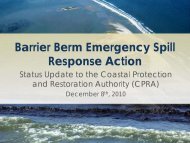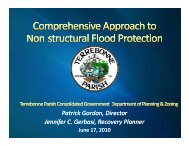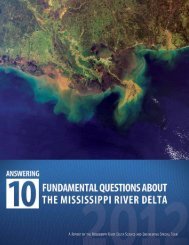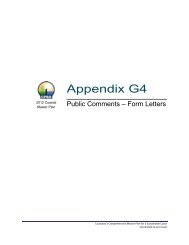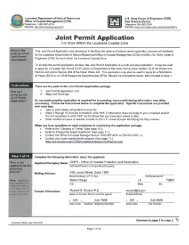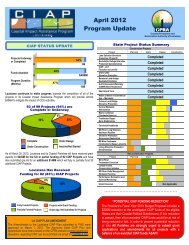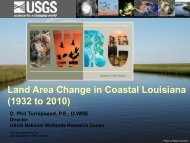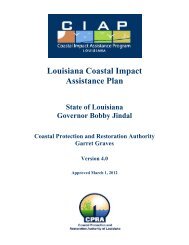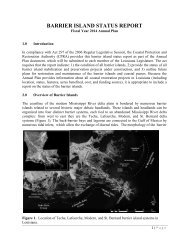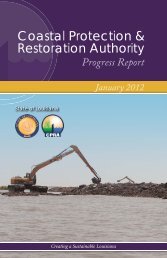Largemouth Bass Habitat Suitability Index Technical Report
Largemouth Bass Habitat Suitability Index Technical Report
Largemouth Bass Habitat Suitability Index Technical Report
You also want an ePaper? Increase the reach of your titles
YUMPU automatically turns print PDFs into web optimized ePapers that Google loves.
APPENDIX D‐9 LARGEMOUTH BASS HABITAT SUITABILITY INDEX TECHNICAL REPORTcause direct mortality. Excessively warm and cold temperatures will cause bass mortality byfreezing or by protein breakdown in high temperatures (e.g., upper 30s C). <strong>Largemouth</strong> basssurvive far into the northern United States and southern Canada, and overwinter successfullyunder ice. Therefore, only extreme temperatures, which are not experienced in coastalLouisiana, are a concern. Salinity only causes mortality at high levels, and salinities near zero arereadily tolerated. <strong>Largemouth</strong> bass are designed to retain and absorb ions at the gills passingexcess ions in the urine because their primary habitat is hypotonic (i.e., less ions in the waterthan their blood). In high salinities, ions enter through the gills at rates greater than may bepassed in the urine; therefore, imbalances in internal ionic concentrations may cause acute toxicmortality. Dissolved oxygen values were not available for this model, however, similar tosalinity, only extreme values in one direction, very low, are problematic. Therefore, onlytemperature and salinity factors included suitability values of 0. Other model componentswould only be considered stressors in relation to growth and reproductive success and did notinclude 0 values, except aquatic habitat parameter that forced the model to keep the fish inwater.The development of the model then followed that optimal ranges of model inputs wereassigned a suitability of 1.0 and sub‐optimal to lethal values were either reported directly fromthe literature or derived from provided data. <strong>Suitability</strong> curves were fit with polynomial or logitmodels, if expectations had to be derived, such that optimal values were 1.0, less optimal valueswere 1.0 > value > 0 with the relative value based on reported abundance, density, orpresence/absence data (i.e., habitat variable values associated with higher reported densities orcatch‐per‐unit‐effort would be closer to 1.0 and lower values would be scaled closer to 0). Then,the HSI was developed to predict suitability on a 0 – 1.0 scale for each cell per year. Becausephysicochemical data and catch‐per‐unit‐effort from four fish sampling events were withheldfrom model development, these data were used to validate the HSI. Subsequent to thisvalidation effort, the HSI was further modified following an iterative process with CPRA to betterfit the HSI to available inputs.V1 ‐ percent emergent vegetation per 500m 2V2 ‐ average water temperature for April to AugustV3 ‐ maximum yearly salinity for June to AugustV6 ‐ percent of cell that is SAV per 1km 2V7 ‐ index value of primary productivity in open watersHSI = [(SI 1 x SI 7 ) 1/8 x (SI 1 x SI 6 ) 1/8 x (SI 2 x SI 3 x SI 7 ) 1/12 x (SI 2 ) 1/4 ]Variables V4 (water depth) and V5 (habitat similarity) were initially proposed for this model;however, through an iterative process in cooperation with CPRA during model output qualityreview, the variables were removed.In the equation above, the SIs are weighted following Stuber’s (1982) HSI. In Stuber’s (1982)HSI, suitability was based on four equally‐weighted factors that influence largemouth basshabitat selection, which were food, cover, water quality, and reproductive potential. In theoriginal HSI, 22 variables were used to describe the four factors. To ensure that the product ofthe geometric mean was bounded by 0 and 1, variables were grouped by the factor that theydescribed and weighted such that each group of variables only contributed 25% to the product.In this HSI, variables were also grouped to address food (SI 1 and SI 7 ), cover (SI 1 and SI 6 ), waterLouisiana’s Comprehensive Master Plan for a Sustainable CoastPage 5



